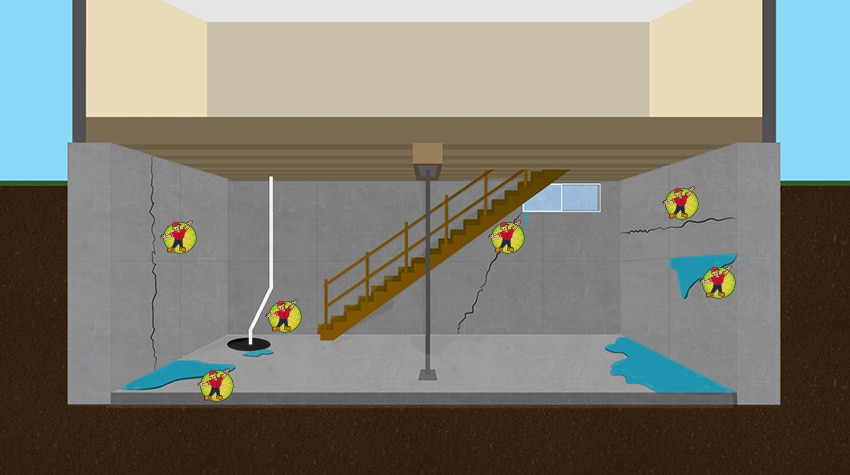Basement Waterproofing, Foundation Repair, and Crawl Space Encapsulation
Accurate sewer
line inspection
services.
Clear
clogged
pipes
Professional Basement Waterproofing & Foundation Repair Services
Serving Akron, Cleveland, Hudson, and the Surrounding Area
Our main goal is to get the job done right the first time! We want every customer of ours to feel confident that when the job is done, they no longer need to worry about the serious problem that water intrusion can be. We know that if given the opportunity to identify the problem and explain in person our solution that you will feel confident that your water problem is over. See our testimonials section to view reviews and ratings by our satisfied customers. We take our cleanup process just as serious. We want to repair the water problem that you have in and around your home and leave as if it never happened. In addition to fixing foundations and being expert waterproofing contractors, we can also provide you with crawl space encapsulation and sewer line inspections. Our team is trained to manage a variety of foundation, waterproofing, and crawlspace issues, and can handle anything from exterior issues to interior waterproofing issues. If you are in need of waterproofing for your basement or foundation you can contact us to get a free estimate or call us to schedule an appointment immediately.Get A Free
Estimate Today!
Give us a call today to schedule an appointment for a consultation, or to speak with a member of our team. We appreciate your interest in our business.
Diagnose Your Wet Basement
Our team at J.D. Johnson Waterproofing has evaluated almost every type of basement and foundation issue possible. We have compiled a list of the most common basement waterproofing and foundation issues that we come across to provide you with a tool to diagnose what is causing water to enter into your basement. Hover over our logo above any of the problems you have noticed in your basement to learn more about how our team can help you keep your home dry and safe.
Large amounts of water around the perimeter of your basement can cause a number of issues in your home. Our team installs interior waterproofing drainage systems to prevent water from seeping through the seam where the wall meets the floor.
Basement windows can cause a number of issues when they start leaking. This is most often caused by foundation settlement causing the seal to break around the window frame.
Horizontal wall cracks are a sign of bowing basement walls. They occur most often on homes with a foundation built out of concrete block. This should be addressed immediately as it can compromise the structural integrity of your home.
Foundations built out of concrete blocks are more likely to allow water to seep through. This will often look like condensation or dark wet spots on your basement walls. This can be a sign that your foundation has damage on the exterior that needs to be addressed.

Vertical Crack
Vertical wall cracks can not only weaken your foundation but they can also provide an opening for water to enter your home. Our team repairs vertical foundation wall cracks with a patented carbon fiber wall repair product.
Learn More
Sump Pump Failure
Sump pumps are an important component in your waterproofing system. If your sump pump fails or breaks our team can replace the broken unit with a more effective one.
Learn More
Water Coming Up From Seam
Large amounts of water around the perimeter of your basement can cause a number of issues in your home. Our team installs interior waterproofing drainage systems to prevent water from seeping through the seam where the wall meets the floor.
Learn More
Window Sill Leak
Basement windows can cause a number of issues when they start leaking. This is most often caused by foundation settlement causing the seal to break around the window frame.
Learn More
Horizontal Wall Crack
Horizontal wall cracks are a sign of bowing basement walls. They occur most often on homes with a foundation built out of concrete block. This should be addressed immediately as it can compromise the structural integrity of your home.
Learn More
Water Seepage
Foundations built out of concrete blocks are more likely to allow water to seep through. This will often look like condensation or dark wet spots on your basement walls. This can be a sign that your foundation has damage on the exterior that needs to be addressed.
Learn More
Counties We Serve
- Cuyahoga County
- Geauga County
- Portage County
- Summit County
J.D. Johnson Waterproofing - In The News
Protect your home and basement with the help of our experts at J.D. Johnson Waterproofing. Recently our basement expert and CEO of J.D. Johnson Waterproofing, Rusty Johnson, was on the news to explain how some of our basement waterproofing techniques work to keep your home dry and protected even after heavy rains. Check out the video to learn more.

